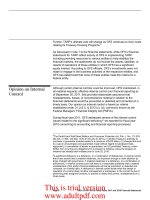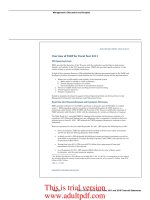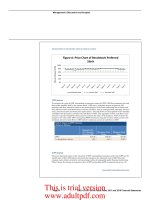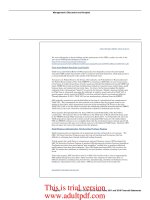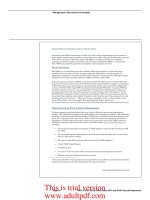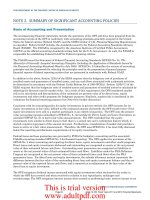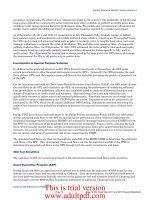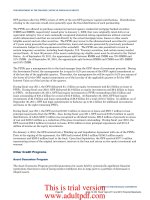United States Government Accountability Office GAO November 2011_part4 pdf
Bạn đang xem bản rút gọn của tài liệu. Xem và tải ngay bản đầy đủ của tài liệu tại đây (422.78 KB, 11 trang )
Management’s Discussion and Analysis
THE DEPARTMENT OF THE TREASURY | OFFICE OF FINANCIAL STABILITY
MANAGEMENT‘S DISCUSSION AND ANALYSIS
PPPIP Analysis
To estimate the value of OFS’ outstanding investments under the PPIP, OFS first estimates the cash
flows of the portfolio held by the various funds. OFS uses a stochastic process to generate 300
potential cash flow outcomes, based on the characteristics of the loans underlying the securities and
their behavior under simulated macro economic variables, such as unemployment, mortgage interest
rates, short-term rates and home price appreciation. The cash flows are then applied to the waterfall
established for the funds to estimate the cash flows to OFS. The aggregate of these cash flows (each
scenario is equally weighted) is discounted to estimate the value of the program. Table 8 shows the
change in the value of the OFS’ outstanding PPIP investment using the scenario which produces the
minimum amount of cash flows to OFS and the maximum amount of cash flows to OFS.
Table 8: Impact on PPIP Valuation
(Dollars in Billions)
September 30,
2011 Reported
Value for PPIP
Maximum Cash
Flows
Minimum Cash
Flows
PPIP $18.38 $19.59 $18.28
% change from current N/A 4.6% (2.4)%
AIFP Analysis
The most important inputs to the valuation of OFS’ outstanding investments under the AIFP are the
market price of New GM common stock and the change in the estimated value of Ally Financial
common stock, which is driven by certain pricing metrics of comparable public financial institutions.
Table 9 shows the change in estimated value of OFS outstanding AIFP investments based on a 10
0%
20%
40%
60%
80%
100%
Price as a Percent of Par
Figure A: Price Chart of Benchmark Preferred
Stock
Market Value Increase 10% Decrease 10%
Page 31 GAO-12-169
OFS's Fiscal Years 2011 and 2010
Financial Statements
This is trial version
www.adultpdf.com
Management’s Discussion and Analysis
AGENCY FINANCIAL REPORT | FISCAL YEAR 2011
MANAGEMENT‘S DISCUSSION AND ANALYSIS
percent increase and 10 percent decrease in the trading price of the New GM common stock and
separately a 10 percent increase and 10 percent decrease in the estimated value of the Ally Financial
common stock. Figure B shows that the New GM securities have recently been trading within the
range used in the analysis as well as outside of this range, illustrating the uncertainty around the
cost estimates.
TTable 9: Impact on AIFP Valuation
((Dollars in Billions)
SSeptember 30,
2011 Reported
Value for AIFP
Effect of 10%
Increase
Effect of 10%
Decrease
Impact of GM on AIFP $17.84 $18.85 $16.83
% change from current N/A 5.7% (5.7)%
Impact of Ally (formerly
GMAC) on AIFP $17.84 $18.61 $17.06
% change from current N/A 4.3% (4.3)%
Figure B shows the daily closing price of the New GM common stock since the initial public offering
in November 2010. The closing price for September 30, 2011 was $20.18. The dashed lines
represent the high and low price used in the sensitivity analysis.
AIG Investment Program Analysis
The most important input to the valuation of OFS’ outstanding investments under the AIG
Investment Program is the market price of AIG common stock. As a sensitivity analysis, OFS
increased and decreased the value of the AIG common stock by 10 percent. Table 10 shows the
impact on the value of OFS’ outstanding investment in AIG as a result of a 10 percent increase and a
10 percent decrease in the value of the AIG common stock.
0
5
10
15
20
25
30
35
40
45
$ Price
Figure B: Daily Price of GM Common Stock
Daily Closing Price Increase 10% Decrease 10%
Page 32 GAO-12-169
OFS's Fiscal Years 2011 and 2010
Financial Statements
This is trial version
www.adultpdf.com
Management’s Discussion and Analysis
THE DEPARTMENT OF THE TREASURY | OFFICE OF FINANCIAL STABILITY
MANAGEMENT‘S DISCUSSION AND ANALYSIS
TTable 10: Impact on AIG Investment Program Valuation
((Dollars in Billions)
SSeptember 30, 2011
RReported Value for
AAIG Investment
EEffect of 10%
IIncrease
EEffect of 10%
DDecrease
AIG Investment Program $30.37 $32.48 $28.26
% change from current N/A 6.9% (6.9)%
Figure C shows the daily closing price of the AIG common stock (closing price on September 30,
2011, was $21.95 per share) with the dashed lines representing the prices used in the sensitivity
analysis. Figure C shows that the securities have been trading within the range used in the analysis
as well as outside of this range. This helps to illustrate the uncertainty around the cost estimates.
0
10
20
30
40
50
60
$ Price
Figure C: Daily Price of AIG Common Stock
Daily Closing Price Increase 10% Decrease 10%
Page 33 GAO-12-169
OFS's Fiscal Years 2011 and 2010
Financial Statements
This is trial version
www.adultpdf.com
Management’s Discussion and Analysis
AGENCY FINANCIAL REPORT | FISCAL YEAR 2011
MANAGEMENT‘S DISCUSSION AND ANALYSIS
Systems, Controls, and Legal Compliance
MManagement Assurance Statement
The Office of Financial Stability’s (OFS) management is responsible for establishing and
maintainin
g effective internal control and financial management systems that meet the objectives of
the Federal Managers’ Financial Integrity Act (FMFIA), 31 U.S.C. 3512(c),(d). OFS has evaluated
its management controls, internal controls over financial reporting, and compliance with the federal
financial systems standards. As part of the evaluation process, we considered the results of
extensive documentation, assessment and testing of controls across OFS, as well as the results of
independent audits. We conducted our reviews of internal controls in accordance with FMFIA and
OMB Circular A-123.
As a result of our reviews, management concludes that the management control objectives described
below, taken as a whole, were achieved as of September 30, 2011. Specifically, this assurance is
provided relative to Sections 2 (internal controls) and 4 (systems controls) of FMFIA. OFS further
assures that the financial management systems relied upon by OFS are in substantial compliance
with the requirements imposed by the Federal Financial Management Improvement Act (FFMIA).
OFS’ internal controls are designed to meet the management objectives established by Treasury and
listed below:
a. Programs achieve their intended results;
b. Resources are used consistent with the overall mission;
c. Program and resources are free from waste, fraud, and mismanagement;
d. Laws and regulations are followed;
e. Controls are sufficient to minimize any improper or erroneous payments;
f. Performance information is reliable;
g. Systems security is in substantial compliance with all relevant requirements;
h. Continuity of operations planning in critical areas is sufficient to reduce risk to reasonable
levels; and
i. Financial management systems are in compliance with federal financial systems standards,
i.e., FMFIA Section 4/FFMIA.
Sincerely,
Timothy G. Massad
Assistant Secretary for Financial Stability
In addition, OFS management conducted its assessment of the effectiveness of internal control over
financial reporting, which includes safeguarding of assets and compliance with applicable laws and
regulations, in accordance with OMB Circular A-123, Management’s Responsibility for Internal
Control, Appendix A, Internal Control over Financial Reporting. Based on the results of this
evaluation, OFS provides unqualified assurance that internal control over financial reporting is
appropriately designed and operating effectively as of September 30, 2011, with no related material
weaknesses noted.
Page 34 GAO-12-169
OFS's Fiscal Years 2011 and 2010
Financial Statements
This is trial version
www.adultpdf.com
Management’s Discussion and Analysis
THE DEPARTMENT OF THE TREASURY | OFFICE OF FINANCIAL STABILITY
MANAGEMENT‘S DISCUSSION AND ANALYSIS
IInternal Control Program
OFS management remains committed to maintaining effective internal controls in safeguarding
taxpayer dollars while providing financial stability through the TARP. OFS continues to have a high
performing internal control program in compliance with the Federal Managers’ Financial Integrity
Act (FMFIA). OFS’ Internal Control Program Office (ICPO) works closely with program managers
and support personnel to maintain robust internal controls across business functions. ICPO also
coordinates with OFS’ Office of Financial Agents (OFA) to ensure that third party service providers
whose work has a potential financial reporting impact on OFS have well designed and effective
internal control environments supporting TARP. During fiscal year 2011, OFS made significant
progress in continuing to mature its internal control environment as demonstrated below:
x Business processes supporting existing programs, including internal control activities,
matured through the use of increasingly well-defined roles and responsibilities and policies
and procedures. OFS management regularly monitors activities to confirm that control
procedures are performed consistently and as designed.
x OFS made significant progress in addressing findings and areas for improvement in the
internal control environment identified through OFS' self assessment processes (e.g., OMB
Circular A-123 internal controls over financial reporting assessment, annual assurance
statement process) and through work performed by the oversight bodies (i.e., GAO,
SIGTARP, and COP).
x OFS made investments in information technology (IT) in fiscal year 2011 to drive efficiencies
through the increased automation of the operational and accounting environment.
OFS has a Senior Assessment Team (SAT) to guide the office’s efforts to meet the statutory and
regulatory requirements surrounding a sound system of internal control. The SAT is chaired by the
Deputy Chief Financial Officer and includes representatives from all OFS functional areas.
Furthermore, OFS has an internal control framework in place that is based on the principles of the
Committee of Sponsoring Organizations of the Treadway Commission (COSO). The SAT leverages
this framework in communicating control objectives across the organization and to its third party
service providers.
ICPO operates under the direction of the CFO and is guided by the SAT. ICPO monitors the
implementation of the internal control framework and is responsible for assessing the achievement
of management control objectives by:
x Integrating management controls into OFS business processes through:
o Maintaining internal control documentation,
o Reviewing internal control responsibilities with business owners before major
program execution events, and
o Real-time monitoring of control effectiveness during and after significant program
execution events;
x Conducting “lessons learned” sessions to identify and remediate areas requiring
improvement;
x Performing periodic sample-based testing of key controls across mature business processes;
and,
x Monitoring feedback from oversight bodies.
Page 35 GAO-12-169
OFS's Fiscal Years 2011 and 2010
Financial Statements
This is trial version
www.adultpdf.com
Management’s Discussion and Analysis
AGENCY FINANCIAL REPORT | FISCAL YEAR 2011
MANAGEMENT‘S DISCUSSION AND ANALYSIS
In addition, the internal control environment supporting TARP undergoes continuous improvement
to remain effective and is subject to significant third party oversight by the GAO and the SIGTARP.
The Assistant Secretary for Financial Stability reports annually to the Under Secretary for Domestic
Finance on the adequacy of the various internal controls throughout the OFS, to include financial
management systems compliance. This assurance statement covers OFS’ compliance with the
FMFIA, the Federal Financial Management Improvement Act (FFMIA), and OMB Circular A-123
Management’s Responsibility for Internal Control. In order to support the Assistant Secretary’s
letter of assurance, the respective OFS functional areas prepare individual statements of assurance.
These individual statements of assurance provide evidence supporting the achievement of OFS’
internal control objectives and disclose any noted internal control weaknesses.
Information Technology Systems
In fiscal year 2011, OFS continued to utilize and improve the Core Investment Transaction Flow
(CITF), TARP’s system of record and accounting translation engine. OFS added standardized
management reports to CITF to improve its usefulness to management decision-making and added
functionality to capture intradepartmental activity to facilitate year-end financial reporting activity.
Other systems are supported by financial agents, which provide services to OFS. The Financial
Agency Agreements maintained by the Treasury Office of the Fiscal Assistant Secretary in support
of OFS require financial agents to design and implement suitably robust security plans and internal
control programs, to be reviewed and approved by OFS at least annually.
In addition, OFS utilizes financial systems maintained by Treasury Departmental Offices and
various Treasury bureaus. These systems are in compliance with federal financial systems
standards and undergo regular independent audits.
Compliance with the Improper Payments Elimination and Recovery Act (IPERA)
The elimination of improper payments is a major focus of OFS senior management. Managers are
held accounta
ble for developing and strengthening financial management controls to detect and
prevent improper payments, and thereby better safeguard taxpayer dollars.
OFS carried out its fiscal year 2011 IPERA review per Treasury-wide guidance and did not assess
any programs or activities as susceptible to significant erroneous payments. OFS did not identify
any payments to incorrect payees or ineligible recipients. However, management did identify a
small number of Making Home Affordable (MHA) investor cost share payments that were made in
error due to unclear guidelines related to escrow payments and data integrity issues from servicers
related to income. The overall impact of these improper payments was immaterial, and OFS
management is actively implementing corrective actions at the servicer level to remedy this issue.
In coordination with OFS, Freddie Mac, one of Treasury’s financial agents, first performed a
comprehensive analysis of potential Monthly Investor Cost Share incentive overpayments and
underpayments in August and September 2010. Subsequent to that analysis, Freddie Mac provided
servicers with additional guidance for correctly calculating borrower income and capturing the
correct escrow data. As a result, the error rates have dropped significantly in fiscal year 2011. OFS
and Freddie Mac expect this error rate to continue to decrease as servicers address additional issues.
OFS will continue to monitor this issue closely.
Page 36 GAO-12-169
OFS's Fiscal Years 2011 and 2010
Financial Statements
This is trial version
www.adultpdf.com
Management’s Discussion and Analysis
THE DEPARTMENT OF THE TREASURY | OFFICE OF FINANCIAL STABILITY
MANAGEMENT‘S DISCUSSION AND ANALYSIS
AAreas for Improvement
Over the next year, OFS management will focus on maturing its internal control environment in
several key areas as follows:
x As programs continue to mature and continue winding down, there is a continued need
for OFS to maintain policies and procedures, which includes updating or retiring
documents as appropriate.
x OFS relies on financial agents to provide many of the business processes and controls
supporting its programs. The Treasury Housing programs, in particular, have grown in
scale and complexity over the last year. OFS continues to assess the adequacy of
internal controls provided by third parties as they mature their program capabilities.
However, OFS will need to heighten its oversight practices to monitor controls as these
programs further mature.
x The large number and complexity of TARP programs and related transactions pose
challenges in the maintenance of the supporting internal control documentation and
policies and procedures. OFS needs to enhance its ability to monitor and ensure
consistency across critical documents detailing the controls in place to mitigate the risks
identified.
x Over the past year, OFS developed information technology capabilities to increase
efficiency and automate manual processes. Continuing this automation will enhance
OFS’ ability to reduce risks associated with human error. In addition, OFS management
will continue to strengthen IT-related controls towards a more mature IT environment
supporting core business processes.
Limitations of the Financial Statements
The principal financial statements have been prepared to report the financial position and results of
operations of the OFS’ TARP program, consistent with the requirements of 31 U.S.C. 3515(b). While
the statements have been prepared from the books and records of the Office of Financial Stability
and the Department of the Treasury in accordance with section 116 of EESA and Generally Accepted
Accounting Principles (GAAP) for Federal entities and the formats prescribed by the OMB, the
statements are in addition to the financial reports used to monitor and control budgetary resources
which are prepared from the same books and records.
The statements should be read with the realization that they are for a component of the U.S.
Government, a sovereign entity.
Page 37 GAO-12-169
OFS's Fiscal Years 2011 and 2010
Financial Statements
This is trial version
www.adultpdf.com
Management’s Discussion and Analysis
AGENCY FINANCIAL REPORT | FISCAL YEAR 2011
MANAGEMENT‘S DISCUSSION AND ANALYSIS
Operational Goals
OOPERATIONAL GOAL ONE: ENSURE THE OVERALL STABILITY AND LIQUIDITY OF THE
FINANCIAL SYSTEM
The following discussion of OFS goals and the TARP programs focuses largely on the significant
events that occurred during fiscal year 2011. A more comprehensive discussion of each program,
including its development and prior years’ performance can be found in the TARP Two-Year
Retrospective and The TARP Three Year Anniversary Report, which are available at:
/>room/reports/agency_reports/Pages/default.aspx.
The first and most significant goal of TARP is to restore stability to the financial system. Despite
recent volatility in the stock market and shocks in the global economy, the U.S. financial system
today is more stable than it was during the midst of the 2008 crisis.
Financial markets and the economy continue to recover. Credit remains available for consumers and
businesses. Financial institutions hold more capital relative to risk than they did before the crisis
hit. Most of the government’s emergency responses to the crisis are being wound down and 76
percent of TARP investments have been recovered through repayments, sales, dividends, interest
and other income.
Bank Support Programs (CPP, TIP, AGP, CDCI)
Capital Purchase Program
OFS launched the Capital Purchase Program (CPP), the largest and most significant program under
EESA, on October 14, 2008. Through the CPP, OFS provided capital infusions directly to banks and
thrifts deemed viable by their regulators to bolster the capital position of institutions of all sizes and,
in doing so, to build confidence in these institutions and the financial system as a whole. With the
additional capital, CPP participants were better equipped to undertake new lending and continue to
provide other services to consumers and businesses, even while absorbing write-downs and charge-
offs on loans that were not performing.
CPP investments were made available to qualifying financial institutions (QFIs) of all sizes and
types across the country, including banks, savings and loan associations, bank holding companies
and savings and loan holding companies. QFIs interested in participating in the program had to
submit an application to their primary federal banking regulator.
In the period following announcement of the CPP, OFS provided $205 billion in capital to 707
institutions in 48 states, including more than 450 small and community banks and 22 certified
community development financial institutions (CDFIs) (see Table 11 below). The largest investment
was $25 billion and the smallest was $301,000. As Table 11 illustrates, smaller financial
institutions make up the vast majority of participants in the CPP. Of the 707 applications approved
and funded by OFS through the CPP by the time it closed to new institutions on December 31, 2009,
473 or 67 percent were institutions with less than $1 billion in assets.
Page 38 GAO-12-169
OFS's Fiscal Years 2011 and 2010
Financial Statements
This is trial version
www.adultpdf.com
Management’s Discussion and Analysis
THE DEPARTMENT OF THE TREASURY | OFFICE OF FINANCIAL STABILITY
MANAGEMENT‘S DISCUSSION AND ANALYSIS
Table 11:CPP Initial Investment Profile
(Dollars in billions)
CPP Participants TARP Investment
Asset Range Number Percent Amount Percent
<$1 billion 473 66.9% 3.8 1.8%
$1 billion - $10 billion 177 25.0% 10.0 4.9%
>$10 billion 57 8.1% 191.1 93.3%
Total 707 100% 204.9 100%
OFS received preferred stock or debt securities in exchange for these investments. Most financial
institutions participating in the CPP pay OFS a dividend rate of five percent per year, which will
increase to nine percent a year after the first five years. From inception of the program through
September 30, 2011, OFS has received approximately $185 billion in CPP repayments, along with
approximately $11.2 billion in CPP dividends and interest and $6.9 billion in net proceeds received
from the sale of Citigroup common stock in excess of cost.
As part of a June 2009 Exchange Agreement between OFS and Citigroup, OFS exchanged the $25
billion in preferred stock it received in connection with Citigroup’s participation in CPP for
approximately 7.7 billion shares of common stock at a price of $3.25 per share. In December 2010,
OFS completed the sale of all remaining 2.4 million shares of common stock in Citigroup. Proceeds
were $10.5 billion, at a price per share of $4.35. OFS had previously sold 5.3 billion shares at an
average price of $4.04 under four trading plans during the period April to December, 2010. The
average selling price for all 7.7 billion shares was $4.14 per share compared to a cost of $3.25 per
share. In January 2011, OFS completed a public auction of warrants to purchase Citigroup common
stock. Proceeds from the warrants associated with the CPP, at an exercise price of $17.85, totaled
$54.6 million.
7
OFS also received warrants to purchase common shares or other securities from the financial
institutions at the time of the CPP investment. The purpose of the additional securities is to provide
opportunities for taxpayers to reap additional returns on the investments made by OFS as CPP
participants recover. From inception of the program through September 30, 2011, OFS has received
nearly $7.6 billion in proceeds from the sale/repurchase of CPP warrants.
The CPP has already generated a positive return to taxpayers; however, the ultimate return will
depend on several factors, including market conditions and performance of individual companies.
For additional information, please see the CPP Quarterly Report and the Annual Use of Capital
Survey which can be found at:
/>.
Refinancing Through the Small Business Lending Fund
As of September 30, 2011, 137 CPP institutions have refinanced their CPP investments using the
SBLF totaling more than $2 billion. The refinancing of CPP institutions into the SBLF decreased
projected costs to OFS by fully repaying the total OFS investment in 137 institutions. These
7
As of September 30, 2011, OFS had exited from all TARP investments (including CPP, TIP and AGP) in
Citigroup with proceeds greater than cost in the amount of $12.3 billion on the $45 billion invested in the institution.
In addition to CPP proceeds reported above, proceeds from the warrants associated with TIP and AGP, with an
exercise price of $10.61, totaled $257.6 million.
Page 39 GAO-12-169
OFS's Fiscal Years 2011 and 2010
Financial Statements
This is trial version
www.adultpdf.com
Management’s Discussion and Analysis
AGENCY FINANCIAL REPORT | FISCAL YEAR 2011
MANAGEMENT‘S DISCUSSION AND ANALYSIS
refinancing transactions moved the risk associated with these institutions’ repayments from OFS to
SBLF. Enacted into law as part of the Small Business Jobs Act of 2010, the SBLF was established
as a $30 billion fund administered by Treasury that encourages lending to small businesses by
providing capital to qualified community banks with assets of less than $10 billion. SBLF is not a
TARP program and does not use TARP funds.
TTargeted Investment Program
OFS established the Targeted Investment Program (TIP) in December 2008. Through TIP, OFS
sought to prevent a loss of confidence in critical financial institutions, which could result in
significant financial market disruptions, threaten the financial strength of similarly situated
financial institutions, impair broader financial markets, and undermine the overall economy. TIP
was considered “exceptional assistance” for purposes of executive compensation requirements.
OFS invested $20 billion in preferred stock in each of two institutions Bank of America (BofA) and
Citigrou
p under TIP, in addition to those funds that these financial institutions received under the
CPP. In December 2009, both participating institutions repaid their TIP investments in full, with
dividends. Total dividends received from Targeted Investment Program investments were about $3
billion during the life of the program. OFS also received warrants from each bank which provided
the taxpayer with additional gain on the investments when OFS sold the BofA warrant in fiscal year
2010 for $1.2 billion and the Citigroup warrant in fiscal year 2011 for $190.4 million. TIP is closed
and resulted in a positive return for taxpayers.
Asset Guarantee Program
Under the AGP, OFS acted to support the value of certain assets held by qualifying financial
institutions, by agreeing to absorb a portion of the losses on those assets. The program was
conducted jointly by Treasury, the Federal Reserve Bank of New York and the FDIC. Like TIP, it
was designed for financial institutions whose failure could harm the financial system and reduce the
potential for “spillover” to the broader financial system and economy. The AGP was used to assist
BofA and Citigroup in conjunction with the TIP investments in those institutions. The arrangement
with BofA was terminated before it was formally finalized, with BofA paying OFS a termination fee.
Under the terms of the guarantee agreement with Citigroup, OFS, the FDIC, and the FRBNY
received a premium for the guarantee of $7 billion in Citigroup preferred stock and warrants.
Additional information on the two institutions under AGP can be found in the OFS’ FY 2010 Agency
Financial Report available at:
/>room/reports/agency_reports/Documents/2010%20OFS%20AFR%20Nov%2015.pdf.
In connection with the termination of the Citigroup asset agreement in December 2009, Citigroup
cancelled $1.8 billion in preferred stock previously issued to OFS. The FDIC and OFS agreed that,
subject to certain conditions, the FDIC would transfer to OFS $800 million of their Citigroup trust
preferred stock holding plus dividends thereon contingent on Citigroup repaying its previously-
issued FDIC debt under the FDIC’s Temporary Liquidity Guarantee Program which expires on
December 31, 2012. OFS sold the trust preferred securities in October 2010 and the AGP warrants
in January 2011, leaving only the $800 million of trust preferred stock receivable from the FDIC
valued at $739 million at September 30, 2011.
The AGP is now closed and resulted in a positive return for taxpayers. No OFS payments were made
under the program.
Page 40 GAO-12-169
OFS's Fiscal Years 2011 and 2010
Financial Statements
This is trial version
www.adultpdf.com
Management’s Discussion and Analysis
THE DEPARTMENT OF THE TREASURY | OFFICE OF FINANCIAL STABILITY
MANAGEMENT‘S DISCUSSION AND ANALYSIS
Community Development Capital Initiative
The CDFIs focus on providing financial services to communities underserved by traditional banks
and financial services, such as low- and moderate- income, minority, and other underserved
communities. OFS launched the Community Development Capital Initiative to help viable certified
CDFIs and the communities they serve cope with effects of the financial crisis. Under this program,
CDFI banks and thrifts received investments of capital with an initial dividend or interest rate of 2
percent, compared to the 5 percent rate generally offered under CPP. CDFI banks and thrifts
applied to receive capital up to 5 percent of risk-weighted assets. To encourage repayment while
recognizing the unique circumstances facing CDFIs, the dividend rate will increase to 9 percent after
eight years, compared to five years under CPP.
OFS completed funding under this program in September 2010. The total investment amount for
the CDCI program under TARP is $570 million for 84 institutions, which remained outstanding as of
September 30, 2011. Of this amount, $363.3 million from 28 banks was exchanged from investments
under the CPP into the CDCI.
Credit Market Programs (PPIP, TALF, SBA 7(a))
Public-Private Investment Program
During the financial crisis, many institutions and investors were under extreme pressure to reduce
indebtedness. This de-leveraging process pushed down the market prices for many financial assets,
including troubled legacy securities (i.e., non-agency residential mortgage-backed securities (RMBS)
and commercial mortgage-backed securities (CMBS)) below their fundamental value. Institutions
and investors were trapped with these hard-to-value assets, marked at distressed prices on their
balance sheets, which constrained liquidity and the availability of credit in these markets.
The PPIP was designed to purchase troubled legacy securities (i.e., non-agency RMBS and CMBS) by
providing financing on attractive terms as well as a matching equity investment made by OFS. By
drawing new private capital into the market for legacy RMBS and CMBS, PPIP was designed to help
restart the market for these securities, thereby facilitating the removal of these assets from financial
institutions’ balance sheets and allowing for more credit to become available for consumers and
small businesses.
OFS matches equity dollar-for-dollar and lends up to the amount of equity raised by the PPIFs
established by private sector fund managers for the purpose of purchasing eligible RMBS and CMBS
from eligible financial institutions under EESA. During fiscal year 2011, OFS disbursed $1.1 billion
as equity investment and $2.3 billion as loans to PPIFs. As of September 30, 2011, OFS had equity
investments in PPIFs outstanding of $5.5 billion and loans outstanding of $10.4 billion for a total of
$15.9 billion. As of September 30, 2011, the estimated value of these investments and loans was
approximately $18.4 billion.
PPIFs have the ability to invest in eligible assets over a three-year investment period. They then
have up to five additional years, which may be extended for up to two more years, to manage these
investments and return the proceeds to OFS and the other PPIF investors. PPIP fund managers
retain control of asset selection, purchasing, trading, and disposition of investments. The profits
generated by a PPIF, net of expenses, will be distributed to the investors, including OFS, in
proportion to their equity capital investments. OFS also receives warrants from the PPIFs, which
gives OFS the right to receive a percentage of the profits that would otherwise be distributed to the
private partners that are in excess of their contributed capital. The program structure allows for
risk to be spread between the private investors and OFS and provides taxpayers with the
opportunity for positive returns.
Page 41 GAO-12-169
OFS's Fiscal Years 2011 and 2010
Financial Statements
This is trial version
www.adultpdf.com

